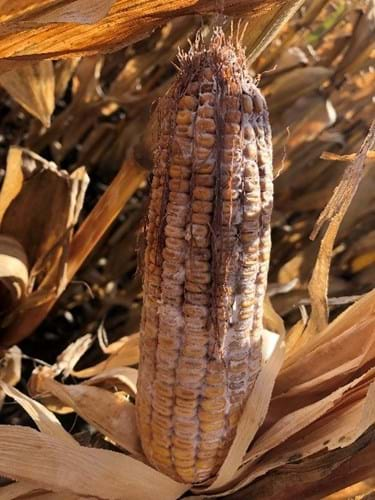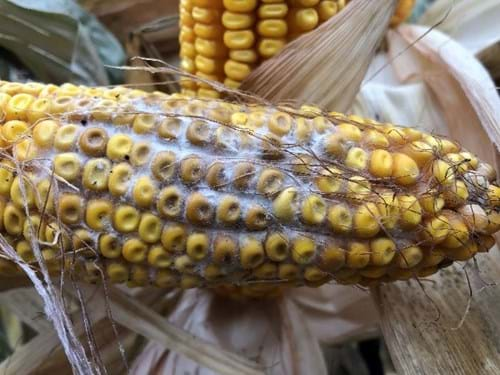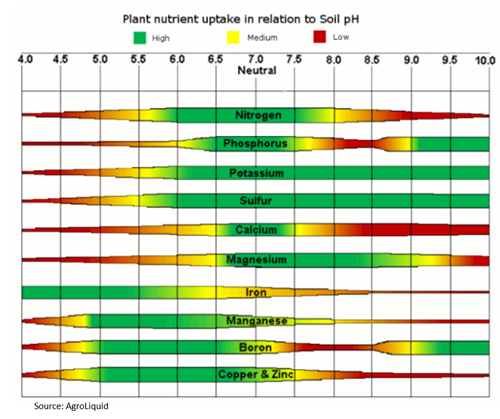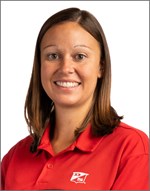Identifying Ear Rots in Corn; Fall Soil Fertility; Alfalfa and Silage Season Summary
BY Dairyland Seed Agronomy Team
COMMON EAR ROTS IN CORN
Harvest is well underway albeit hindered in some areas due to intermittent rainfall. As we examine plots and fields that still stand, we have noted the appearance of ear molds or rots appearing in some areas. Common ear rots that have been identified in the Dairyland Seed footprint are Gibberella, Diplodia, and Aspergillus.
Giberella Ear Rot, Giberella zeae, is most easily identified as pink or red “fuzzy” fungal bodies on and between kernels with infection beginning at the tip. Infection generally occurs during cooler periods 2 to 3 weeks after silking. Giberella over-winters in corn residue as well as wheat residue that was infected with Fusarium Head Blight as it is the same pathogen. Large scale infections of Giberella can cause grain quality issues by producing mycotoxins such as Deoxynivalenol or DON and vomitoxin. These mycotoxins can cause issues when fed to animals especially swine. Testing of suspect grain is preformed to determine levels of DON.

Diplodia Ear Rot, Stenocarpella maydis, is usually gray or white fungal bodies that appear between kernels and can appear at any part of the ear, but infection usually begins at the base of the ear. Small black structures called pycnidia can also be found between kernels, husks or in the cob. Diplodia impacted grain will/can have lower test weight and, in severe cases, can cause storability issues. Severely impacted kernels can germinate if the ear remains upright and water enters the husk. The pathogen overwinters in corn debris so no-till corn back to corn situations with dry conditions prior to silking and wet conditions after silking are at highest risk. Tillage or rotation away from corn will help reduce Diplodia in the soil.

Aspergillus Ear Rot, Aspergillus flavus, is identified by powdery olive-green fungal structures often accompanied with white or black structures as well. Hot and dry growing conditions with otherwise stressed plants, favor infection. Aspergillus creates a mycotoxin in the kernel called aflatoxin. Aflatoxin is harmful and can cause a number of health issues for animals if large amounts of grain are infected. Stress mitigation through proper fertility, as well as drought tolerant hybrid selection, can help reduce chances of infection.
Management of Ear Rot
- Where applicable, tillage can help to eliminate plant tissue where inoculum can over-winter.
- Crop rotation away from susceptible crops. For example, rotating away from corn or small grains in heavily impacted areas.
- Control insects that may damage kernels and allow for infection.
- Minimize storability issues of affected grain by drying to at least 15% moisture. High heat drying is recommended to stop the formation of mycotoxins in the grain.
This article is not meant to incite fear and panic, but to be a tool to help recognize ear molds should they appear in your corn fields. If you have any questions regarding these or other ear molds, please contact your Dairyland Seed DSM or Regional Agronomist for more information.
FALL SOIL FERTILITY
Harvest is beginning to wrap up around the Midwest, which means it’s time to start planning for the 2022 growing season. An important part of that plan is evaluating soil fertility levels and deciding what should be applied this fall. With fertilizer prices up significantly from this time last year, it is a very good idea to take soil samples or review recent soil tests to assess your nutrient levels. While looking at your soil test, be sure to focus on the soil pH first.
Soil pH: Soil pH determines nutrient availability to the crop and influences biology in the soil. If the soil pH is off, there could be ample amounts of a nutrient in the soil, but still unavailable to the plant. pH measures the acidity or alkalinity of soil. The pH scale is logarithmic, so a pH of 5 has a concentration of H+ that is 10x higher than a pH of 6. The target pH for most crops is about 6.5, with alfalfa being closer to 6.8-7.0. Below is a chart showing nutrient availability at each pH.

Base Saturation: Base saturation is the amount of the total CEC that is occupied by base cations. The percent Base Saturation is the ratio of these key cations to each other. Too much or too little of these nutrients may cause other nutrients to be unavailable to the crop.Cation Exchange Capacity (CEC): CEC determines the soil’s nutrient holding capacity. Cations are positively charged ions in the soil. Exchangeable cations easily move between soil particles and plant roots (both are negatively charged). Plant roots release C02, which reacts with water to release a H+ cation into the soil. This H+ can bump another cation from a soil particle to be taken up by the plant. Finer textured soil particles such as clays and organic matter have more negatively charged binding sites and, therefore, higher CEC. Coarse textured soil such as sand has a lower CEC. The main cations that comprise most of the holding capacity are Calcium (Ca), Magnesium (Mg), Potassium (K), Sodium (Na), and Hydrogen (H).
Ideal % Base Saturation for balanced fertility:
- Calcium (Ca)- 65-75%
- Magnesium (Mg)- 13-18%
- Potassium (K)- 3-8%
- Sodium (Na)- Less than 2%
- Hydrogen (H)- 10-15%
Up-to-date soil tests along with yield maps will help identify any deficiencies or problem areas that need to be addressed for next year. Given the high fertilizer prices, if your soil tests show ideal pH, Base Saturation and adequate nutrient levels, then this might be the year to consider applying only what the next crop needs. If your soil tests show a need for potassium and/or phosphorous, then you should consider a fall application to save time in the spring and avoid the higher fertilizer demand. If you have any questions please reach out to your local DSM or Agronomist.
WHAT CAN WE EXPECT FOR ALFALFA AND CORN SILAGE AS WE HEAD INTO THE OFF-SEASON?
Forage harvest season is quickly winding down as the days continue to get shorter reminding us that winter will soon be here. Let’s take a quick look at how this season went for both alfalfa and corn silage as well as what we can expect heading into the off-season.
Alfalfa
- Drought conditions in the western half of the United States, including the Dairyland Seed territory, robbed yield and quality potential from existing fields while severely limiting the success of new seeding.
- Check affected fields for winter survival potential and start making plans for borderline fields
- Many farms were able to get a good jump on 1st crop harvest which meant a lot of them were taking decent 5th cuttings for the first time in a few years
- Late Summer Armyworm infestations across the Upper Midwest wreaked havoc on August alfalfa plants
- Early detection, treatment, and cutting was key to saving a crop; but, in many cases, it was too little too late.
- The warm start to Fall has allowed this infestation to linger, requiring continued vigilance and assessment
- New summer seedings that suffered extreme damage may be completely lost requiring re-seeding in the Spring.
- Overall, alfalfa inventory across the Upper Midwest was not drastically affected by this summer’s weather or insect booms meaning prices should remain steady if anyone is looking to purchase
Corn Silage
- Most of the Dairyland Seed territory saw an extra-early start to harvest as plants quickly reached maturity in the hot, dry August days.
- The first samples out of the forage testing labs were showing similar or better whole-plant moisture AND fiber digestibility than in years past. BUT, these same samples were coming back with much lower starch content and digestibility due to low kernel moisture and excessively hard kernels.
- This lack of starch availability will require longer storage times where possible to help soften those kernels, especially if they were not well-processed heading into storage
- As the Summer heat extended well into September, corn silage plants were quick to dry down prompting some guys to opt to take them all the way to grain and have been getting impressive grain yields to help ease the heartburn
- Fields taken off below 63% moisture need to be monitored closely to ensure a complete and proper fermentation took place to avoid shrink and spoilage.
JOIN THE DAIRYLAND SEED ELITE PRODUCER CLUB
You can be a member of Dairyland Seed’s Elite Producer Club by submitting photos or testimonials of high performing products! Simply test a picture or testimonial of your high performing products to 913-DS-YIELD or 913-379-4353. The program runs from August 15 through December 1, 2021.
Participants will receive a free Dairyland Seed t-shirt (one per entry) and “Elite Yield Club” Certificate. All corn grain, corn silage and soybean products are eligible.
Qualifying products for “Elite Yield” Contest (one winner per family, per region, prize is 3 free units of product that was entered):
Region 1 = DS-3366 family; DS-3550 family; DS-4018 family
Region 2 = DS-3550 family; DS-4018 family; DS-4878 family; DS-5144Q
Region 3 = DS-4310 family; DS-4878 family; DS-5144Q
Region 4 = DS-3366 family; DS-3550 family; DS-4014Q; DS-4310 family
Information required in text: Participant; Location; Product; Yield in Bushels or Tons; T-Shirt Size; DSM; Mailing address if different than participant.
2021 YIELDMASTER CONTEST
Fall harvest kicks off the annual Dairyland Seed Corn, Silage and Soybean Yieldmaster Contest. Take a moment to enter your outstanding yields and you just might be our 2021 winner!
Seed Credits for Winners
- The National Corn, Soybean and Silage Yieldmasters will each receive a $2500 seed credit.
- First Place Corn, Silage and Soybean winners from each zone receive a $1000 seed credit.
- Second Place Corn, Silage and Soybean winners from each zone receive a $500 seed credit.
Entries can be submitted online at www.dairylandseed.com or via your DSM who can submit your entry using the iPad app. Silage entries are due November 3, 2021. Corn and Soybean entries are due December 3, 2021.
 |
 |
 |
 |
 |
| Brian Weller Western Region 507.456.3034 |
Dan Ritter Central Region 219.863.0583 |
Branden Furseth Northern Region 608.513.4265 |
Mark Gibson Eastern Region 260.330.8968 |
Amanda Goffnett Eastern Region 989.400.3793 |
